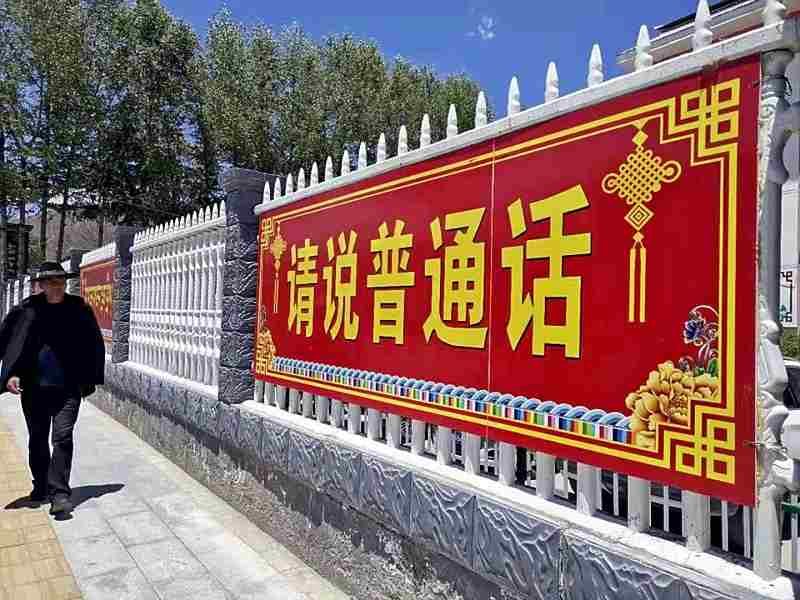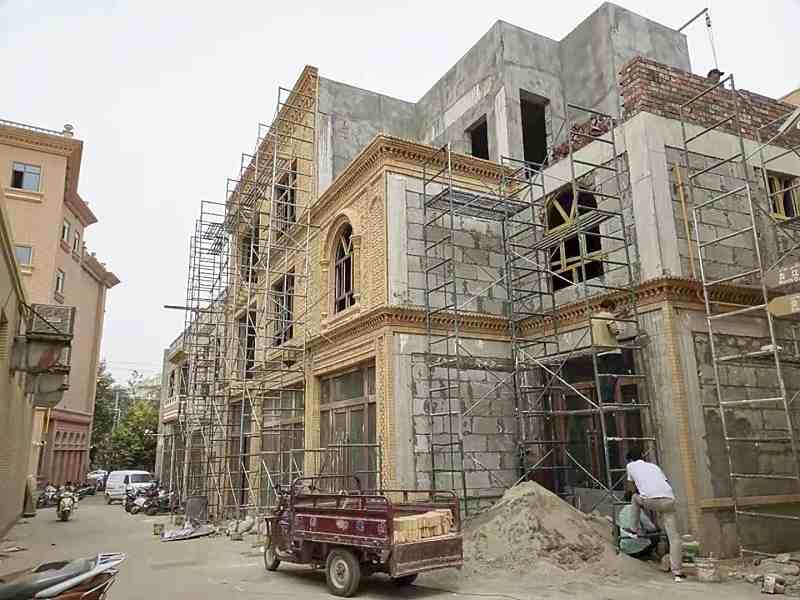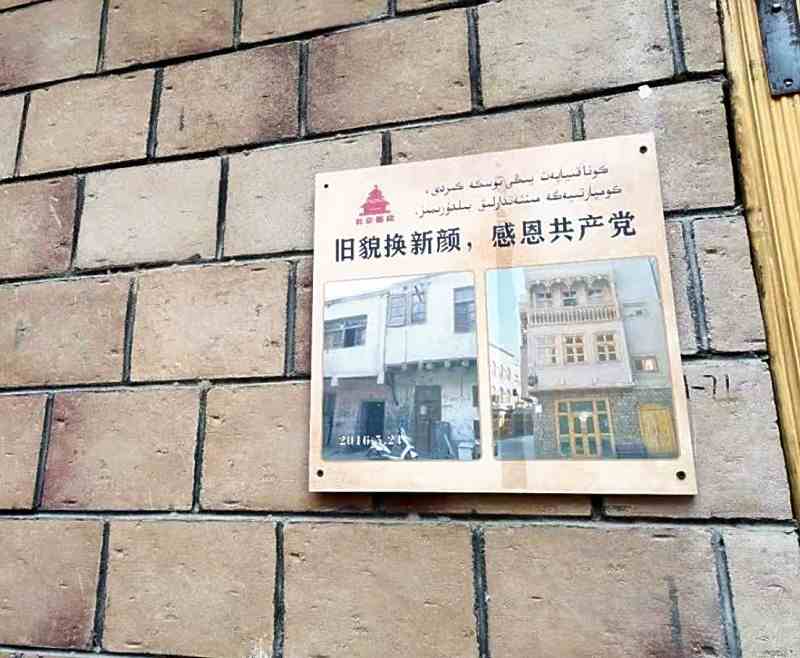CCP at 100: China accelerating efforts to assimilate ethnic minorities into Han Chinese state

A banner with “Please speak Mandarin” written in Chinese characters is seen at a school in a Tibetan neighborhood in Gansu Province, China, in early June.
20:27 JST, July 1, 2021
China on Thursday extravagantly celebrated the 100th anniversary of the founding of the Chinese Communist Party. Under one-party rule, the authoritarian nation wants to show how far it has come as it challenges the hegemony of the United States. This is the first installment of a series looking at the costs of this struggle for supremacy for the people in China and around the world.
Gazing toward a corner where a light bulb’s illumination couldn’t reach, 13 Tibetan women prayed with tears in their eyes. They were in a Tibetan Buddhist temple in a Tibetan residential area of Gansu Province, about 1,700 kilometers west of Beijing.
This particular corner is said to be a blind spot for the surveillance cameras installed by the authorities in the four corners of the ceiling. The object of the women’s attention was a portrait of the 14th Dalai Lama, the spiritual leader of Tibetan Buddhism and a Nobel Peace Prize winner. Even the possession of such an image is forbidden by the Chinese public security authorities.
A monk clad in dark-red clerical garb put his hand on his chest. Wary of the cameras, he whispered: “I know it’s dangerous to do this. But I still want to keep my faith, as the Dalai Lama is in my heart.”
The Dalai Lama is currently based in India, which gave him shelter in 1959 when he fled Tibet during an uprising there.
As of 2014, there were 3,600 Tibetan Buddhist temples in China. Faith in the Dalai Lama as the living Buddha is still strong among ethnic Tibetans, whose population is about 6.3 million. For the Chinese Communist Party (CCP), such a strongly revered symbol is seen to pose a risk of inspiring separatist movements.
The CCP has suppressed the Tibetan Buddhist faith, branding the Dalai Lama as a “separatist.”
A Tibetan man said the number of surveillance cameras has increased and controls have been tightened on streets and temples in Tibetan neighborhoods under the leadership of Chinese President Xi Jinping, who calls for the “sinicization of religion,” which puts the teachings of the party above religion.
The authorities often search homes to find people with hidden photos of the Dalai Lama, and punish them as an example.
Near the settlement, a Xi political slogan, “Create a strong sense of community for the Chinese nation,” was written in large characters on a concrete wall. A banner at the gate of a school attended by ethnic Tibetan students read, “Please speak Mandarin.”
After 2008, when large-scale riots broke out in Lhasa, capital of the Tibet Autonomous Region, language education that treated Tibetan as the main language and Mandarin as secondary was changed to present Mandarin as the key language. Moves are underway to assimilate ethnic minorities including the Uighur people whose mother tongue is Uighur and who believe in Islam, into the Han Chinese majority under the name of the “Chinese nation.”
A Tibetan woman lamented that they have no freedom even to die. Until several years ago, there were a number of self-immolations in Tibetan neighborhoods as a protest against authoritarian rule. But the Chinese authorities, who emphasize the success of their ethnic minority policies, do not allow this to happen now. With the advancement of high-tech surveillance systems, the purchase of gasoline in order to commit suicide is said to be soon noticed.
The Chinese Communist Party regime advocates the “autonomy” of ethnic minorities, and the Constitution proclaims “freedom of religious belief.” However, under one-party rule — which above all else does not tolerate secession — these ideas are increasingly existing in name only.

Renovation is underway in a business district in Hotan in the Xinjiang Uygur Autonomous Region in mid-June.
Destruction of minorities’ culture
Hotan in the southwestern part of China’s Xinjiang Uygur Autonomous Region is known for its high percentage of Uighur residents.
In mid-June, identical residential buildings with shops on the ground floor featuring designs resembling the traditional ethnic architecture were being built one after another in the Uighur neighborhood. On the walls of the completed buildings, there were pictures comparing the old mud-walled dwellings before renovations with those built after, with the words, “Gratitude to the Communist Party.”
The local government has been redeveloping about 3,500 houses in the area since 2016. The aim of the project is to improve the living environment and standards of the Uighur people, which were deemed significantly inferior to that of the Han people, by temporarily evicting residents and swiftly transforming the residential area into a commercial area for tourists.
“It’s a good thing for it to change into a beautiful place,” said a Uighur man who was working at a redevelopment site. But there also was an elderly Uighur woman hitting the entrance of her house, which still was under renovation, with a wooden board and shouting something in Uighur. Although the reason was unknown, the woman was pleading for the construction to be halted, according to the neighbors.
As a result of these government projects and priority investments in autonomous regions, the per capita disposable income in the Xinjiang Uygur Autonomous Region increased by an average of 9.1% per year between 2014 and 2019, according to available statistics. The communist party administration insists it is encouraging ethnic minorities to improve their living standards through economic assistance, while allowing their “autonomy” in five autonomous regions, as well as in autonomous states and prefectures based on the regional ethnic autonomy system.
The autonomy system was introduced based on the 1984 law to recognize the rights of minorities to use their own languages and characters, and to grant preferential rights for development to their local governments. But even though ethnic autonomy is touted, Han people monopolize the top posts in autonomous regions and states, and therefore hold the decision-making power.
The international community is now paying attention to the fact that the Chinese authorities are forcibly incarcerating Uighurs.
In mid-June, after driving for about three hours through the desert area stretching from Kashgar in the western part of the autonomous region, with a list of 380 places identified by the Australian Strategic Policy Institute as the location of detention facilities based on satellite photographs and other data, a huge building came into view.

Photographs posted on a house in Hotan in the Xinjiang Uygur Autonomous Region in mid-June compare the old mud-walled dwelling before renovations, left, with a house built after. The words above the photos read, “Gratitude to the Communist Party.”
This was what the institute judged to be one of the most heavily controlled detention facilities, bearing the slogan “Knowledge changes one’s fate, skills make dreams come true.” While completely rejecting the accusation that it engages in forced incarceration, Beijing has acknowledged the existence of a “vocational education and training centers to reeducate Uighurs infected with extremism.”
A Uighur woman who was staring at the building from a distance said her husband was there, and swiftly left on a motorbike. Approaching the building, local residents blocked the way, saying it is prohibited to enter the premise.
In the early days of the CCP, the party even recognized ethnic minorities’ right of national self-determination among others. The then small, weak CCP had to cooperate with ethnic groups other than Han Chinese in order to take control of the country.
However, the party has since expanded to more than 95 million members and is now strengthening carrot and stick policies, not alliances. Kerimu Uda, president of the Tokyo-based Japan Uyghur Association, said the Han-centered communist regime “just forces us to give up our own culture and worship the party. They have no intention of protecting ethnic minorities.”
Uda stressed that Uighurs, who are establishing bases overseas, will not give up their resistance to the Chinese government.
There are reports that at least 16,000 mosques have been damaged and 8,500 demolished in the autonomous region since 2017 by authorities, who regard mosques as breeding grounds for Islamic extremism.
“The mosque next door was closed by the authorities several years ago and turned into a jewelry store. Why do they take even a place to pray away from us?” a Uighur sales clerk in his 30s angrily said at a souvenir store in Kashgar. He, too, was wary of the surveillance cameras installed in the four corners of the store.

A map of China
"Politics" POPULAR ARTICLE
-

Japan to Support Central Asian Logistics Route That Bypasses Russia, Plan to Be Part of Upcoming Summit in Tokyo
-

Japan to Tighten Screening of Foreigners’ Residential Status by Providing Information of Nonpayment of Taxes
-

Chinese, Russian Bombers Flew Unusual Path by Heading Toward Tokyo; Move Likely Meant to Intimidate Japan
-

Japan Plans National Database to Track Foreign Ownership of Real Estate, Land as It Weighs New Rules
-

Up to 199,000 Deaths Estimated From Mega-Tsunami; Most Recent Occurrence Took Place in 17th Century
JN ACCESS RANKING
-

Tokyo Economic Security Forum to Hold Inaugural Meeting Amid Tense Global Environment
-

Keidanren Chairman Yoshinobu Tsutsui Visits Kashiwazaki-Kariwa Nuclear Power Plant; Inspects New Emergency Safety System
-

Imports of Rare Earths from China Facing Delays, May Be Caused by Deterioration of Japan-China Relations
-

University of Tokyo Professor Discusses Japanese Economic Security in Interview Ahead of Forum
-

Japan Pulls out of Vietnam Nuclear Project, Complicating Hanoi’s Power Plans

























